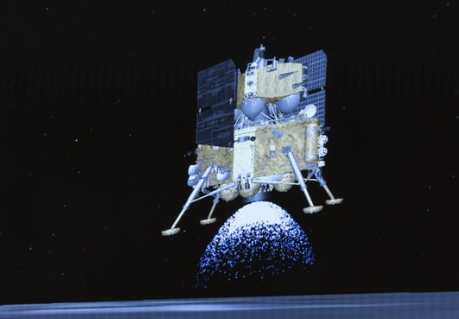Stolen tech from the United States has brought China great fortune, and prowess in space. They are now doing what America has not.
China has made significant strides in its space exploration efforts, most recently with the successful return of lunar samples from the moon’s far side. The Chang’e-6 mission, which began 53 days ago, concluded with the reentry capsule landing on June 25 in Inner Mongolia’s Siziwang Banner grasslands. The capsule, containing nearly two kilograms of lunar material, was promptly transported to Beijing for analysis.
On June 26, scientists retrieved 1,935.3 grams of samples from the capsule, slightly below the mission’s goal of 2,000 grams. Despite this, the mission outperformed the 2020 Chang’e-5 mission, which collected 1,731 grams from the moon’s near side, hindered by drilling issues.
The samples are currently under the care of the National Astronomical Observatories of the Chinese Academy of Sciences (NAOC), which will unseal and prepare them for scientific study. Domestic researchers will have access to these samples after six months, while international scientists can apply for them two years later, in accordance with CNSA’s lunar sample management policies.
#China plans new deep #space missions.
Meanwhile, #Beijing reports that the Chinese probe Chang’e-6 has collected 1935.3 soil samples from the hidden side of the Moon.https://t.co/HUS5blqmYy— Extrema Ratio (@ExtremaRatio4) June 28, 2024
The samples are expected to provide valuable insights into the geological evolution of the moon. According to a 2023 study, the material from the South Pole-Aitken Basin could shed light on the differences between the moon’s near side and far side, offering clues about the early impact history of the solar system. Li Chunlai, deputy chief designer of the Chang’e-6 mission, emphasized the potential for these samples to enhance our understanding of the moon’s geological history.
Clive Neal, a lunar scientist at the University of Notre Dame, highlighted the significance of these samples, noting their potential to reveal unique aspects of the moon’s evolution. However, he cautioned that the ancient terrain of the landing site might mean the material has been altered by subsequent geological processes, which could obscure some of the basin’s original characteristics.
Looking ahead, the China National Space Administration (CNSA) is planning ambitious future missions. The Tianwen-2 mission, set for a 2025 launch, will target the near-Earth asteroid 469219 Kamoʻoalewa for sample collection and later rendezvous with the main-belt comet 311P/PANSTARRS. Additionally, CNSA has outlined plans for the Tianwen-3 Mars sample return and Tianwen-4 Jupiter mission, expected around 2030. The latter mission aims to deploy a solar-powered orbiter around Jupiter and a smaller, radioisotope-powered probe for a flyby of Uranus.
China plans to carry out a pair of new lunar expeditions and three deep-space exploration projects in the near future, according to Bian Zhigang, deputy director of the China National #Space Administration. https://t.co/bXCUCe2vWk
— China Daily (@ChinaDaily) June 27, 2024
China’s space program is also focusing on enhancing its capabilities with heavy-lift launch vehicles and reusable space transportation systems. These advancements are part of broader efforts to strengthen basic research, accelerate the development of critical technologies, and promote innovation in space science and technology.
Next in China’s lunar exploration agenda is the Chang’e-7 mission, targeting the lunar south pole’s Shackleton crater. This mission will be supported by the Queqiao-2 relay satellite. In 2028, the Chang’e-8 mission will follow, with opportunities for international collaboration, as evidenced by over 30 letters of intent from various countries.
The “Eye of Heaven” plays a crucial role in advancing China’s space ambitions.
As the country pursues high-profile projects like the Tiangong space station and lunar exploration missions, FAST provides vital support through its deep-space observation capabilities.
The… pic.twitter.com/GEFiksMJyo
— MadMaKs – 雷王力 🏯👹 (@0xMadMaks) June 28, 2024
CNSA is actively pursuing international cooperation, having signed agreements with over 10 countries for the China-led International Lunar Research Station (ILRS). While specific countries were not named, the CNSA emphasized the importance of removing barriers to collaboration, particularly mentioning the U.S. Wolf Amendment, which restricts NASA’s engagement with China. CNSA officials have expressed a willingness to engage in mutually beneficial cooperation with an open and inclusive approach.
These developments highlight China’s growing role in global space exploration, showcasing its technological advancements and commitment to international collaboration. That bribe money to Biden has gone far as Chinese agents are currently all over the United States, stealing tech at will. China will continue to beat out the United States thanks to Biden and their own people.
Key Points:
i. China’s Chang’e-6 mission successfully returned nearly two kilograms of lunar samples from the moon’s far side, landing in Inner Mongolia on June 25.
ii. The samples are being analyzed by the National Astronomical Observatories of the Chinese Academy of Sciences, with domestic and international researchers set to access them in the coming years.
iii. The mission aims to provide insights into the geological evolution of the moon, particularly the differences between its near and far sides.
iv. China’s upcoming space missions include the Tianwen-2 asteroid and comet mission in 2025, and future missions to Mars and Jupiter around 2030.
v. CNSA is enhancing its space capabilities and seeking international collaboration, with plans for future lunar missions and the China-led International Lunar Research Station.
Al Santana – Reprinted with permission of Whatfinger News



